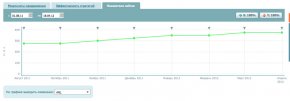
Improved Site Attendance
 For a long time, the promotion of the resource was carried out in all possible ways: by purchasing manual links from webmasters, through cross-exchange of articles, through and through other tools. When I decided what kind of service to choose, ROOKEE♪ I read about this service in the fall of 2010 at www. and I decided to try.
For a long time, the promotion of the resource was carried out in all possible ways: by purchasing manual links from webmasters, through cross-exchange of articles, through and through other tools. When I decided what kind of service to choose, ROOKEE♪ I read about this service in the fall of 2010 at www. and I decided to try.
At first, I thought it was another standard aggregator, but the service was so wide and useful, that most of the work on the site eventually went to ROOKEE.
Since I've already had experience with SEO, all the constructions have been done on their own. We used a free audit in the ROOKEE service, which identified a number of misreports on the website that we highlighted.
To avoid the problems of bad references, we tried to make the reference mass as qualitative as possible, so we used (and now used) white-lists and no longer worry about the quality of our references.
In the process of increasing the site ' s attendance, I have repeatedly contacted the Technical Support Service, and I have been provided promptly and with assistance.
Positions on major requests www. were good before adding to the system, but ROOKEE has helped to substantially save time and funds for the purchase of references.
 The main challenge facing the service is to advance the resource not only on a multitude of routine requests, but also on a multitude of needs. improve website attendance for the artics, as there are more than 50,000 items in the store. The number of requests used in resource promotion has grown steadily (currently about 5,000). Our progress on NFs has not been successful all the time - in a year some positions have fled, some have grown, search traffic has not always been constant. However, some seasonal requests have significantly increased the site ' s attendance.
The main challenge facing the service is to advance the resource not only on a multitude of routine requests, but also on a multitude of needs. improve website attendance for the artics, as there are more than 50,000 items in the store. The number of requests used in resource promotion has grown steadily (currently about 5,000). Our progress on NFs has not been successful all the time - in a year some positions have fled, some have grown, search traffic has not always been constant. However, some seasonal requests have significantly increased the site ' s attendance.
ROOKEE helped us to avoid the fall of the website under the medium we had in November 2011. We have fully updated the site design, and we have changed the filter and product selection systems, correcting all internal optimization gaps.








